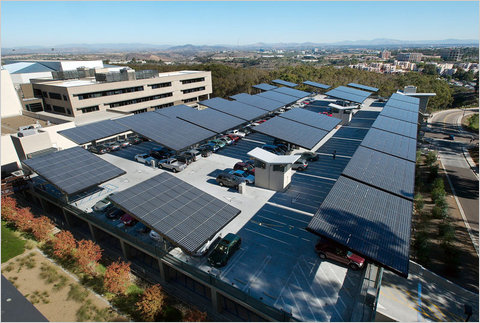All-Electric Vehicles (EVs), while great in theory, face a lot of challenges:
- Driving range: Most EVs can only go about 100–200 miles before recharging—gasoline vehicles can go over 300 miles before refueling.
- Recharge time: Fully recharging the battery pack can take 4 to 8 hours. Even a “quick charge” to 80% capacity can take 30 min.
- Battery cost: The large battery packs are expensive and may need to be replaced one or more times.
- Bulk & weight: Battery packs are heavy and take up considerable vehicle space.
Solar Energy is becoming increasingly affordable and technology has developed to use solar panels to support the infrastructure of EVs. One of the first ways to implement solar energy to power EVs has been the creation of a “Solar Grove.” A Solar Grove consists of numerous solar trees that provide shade in parking lots across the country. Envision Solar worked with Dell in Round Rock, Texas to create 130kW of energy. Dell’s solar grove is expected to help avoid 145,000 emissions of greenhouse gases every year.
Each solar tree provides shade for six normal parking spaces and have now been fitted to be connected to EVs. Each tree can fully charge six vehicles each day.
Solar energy is the most abundant energy resource on earth – 173,000 terawatts of solar energy strikes the Earth continuously. That’s more than 10,000 times the world’s total energy use.
In 2004, Robert Noble, an architect in sustainable design, wondered why parking lots were not covered with solar panels to harness this enormous energy potential. He then created the company Envision Solar, which has since created the solar grove for Dell. Another early adopter was the Kyocera Corporation of Japan, which had Envision Solar construct a large-scale solar grove in 2006 at its United States headquarters in San Diego, where a 235-kilowatt carport harnesses 1,400 of Kyocera’s own solar photovoltaic modules.
Kyocera has also developed a solar grove which consists of 25 solar trees. This solar electric generating facility can produce up to 421,000 kilowatt hours per year — enough to power 68 typical California homes. They have also created a solar grove for the University of California at San Diego, as can be seen in the picture above.
Kycera Solar is also in Brazil and Australia. While the project is still priced out of the range a developing country could afford, developed countries like the US, EU, Australia, and South Korea should seriously considering using solar groves to increase and support the infrastructure for EVs and hybrid cars.




Leave a Reply